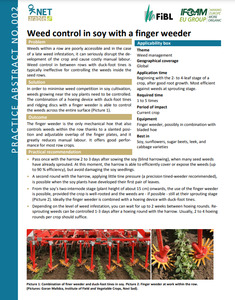{Tool} Weed control in soy with the finger weeder (OK-Net Arable Practice Abstract). [Unkrautregulierung in Soja mit der Fingerhacke.] Creator(s): Dierauer, Hansueli; Siegrist, Franziska and Weidmann, Gilles. Issuing Organisation(s): FiBL - Research Institute of Organic Agriculture. OK-Net Arable Practice Abstract, no. 002. (2017)
Preview |
PDF
- German/Deutsch
(Unkrautregulierung in Soja mit der Fingerhacke)
381kB |
Preview |
PDF
- English
(Weed control in soy with a finger weeder)
364kB |
![[thumbnail of 2023-01-09 16_24_19-Weed control in soy with a finger weeder.png]](/31017/31.hassmallThumbnailVersion/2023-01-09%2016_24_19-Weed%20control%20in%20soy%20with%20a%20finger%20weeder.png)  Preview |
Image (PNG)
- Cover Image
- English
261kB |
Document available online at: https://orgprints.org/31017/
Summary in the original language of the document
The finger weeder is the only mechanical hoe that also controls weeds within the row thanks to a slanted position and adjustable overlap of the finger plates, and it greatly reduces manual labour. It offers good performance for most row crops.
• Pass once with the harrow 2 to 3 days after sowing the soy (blind harrowing), when many seed weeds have al-ready sprouted. At this moment, the harrow is able to efficiently cover or expose the weeds (up to 90 % efficiency), but avoid damaging the soy seedlings.
• A second round with the harrow, applying little tine pressure (a precision tined-weeder recommended), is possible when the soy plants have developed their first pair of leaves.
• From the soy's two-internode stage (plant height of about 15 cm) onwards, the use of the finger weeder is possible, provided the crop is well-rooted and the weeds are - if possible - still at their sprouting stage. Ideally the finger weeder is combined with a hoeing device with duck-foot tines.
• Depending on the level of weed infestation, you can wait for up to 2 weeks between hoeing rounds. Resprouting weeds can be controlled 1-3 days after a hoeing round with the harrow. Usually, 2 to 4 hoeing rounds per crop should suffice.
Summary translation
Als einziges maschinelles Hackgerät entwurzelt die Fingerhacke dank Schrägstellung und regulierbarer Überlappung der Fingerteller gekeimte Unkräuter in den Saatreihen und reduziert damit den Handarbeitsaufwand zur Unkrautregulierung stark. Die Fingerhacke leistet in verschiedenen Kulturen gute Dienste.
• Durchgang mit dem Striegel 2- 3 Tage nach der Saat der Soja (Blindstriegeln), wenn viele Samenunkräuter schon gekeimt sind. In diesem Zeitpunkt kann der Striegel die Unkräuter sehr wirksam verschütten oder freilegen (Wirkungsgrad bis 90 %). Striegel flach genug einstellen und eher langsam fahren.
• Ein zweiter Durchgang mit dem Striegel mit wenig Zinkendruck (Empfehlung: Präzisionshackstriegel) ist möglich, wenn die Sojapflanzen das erste Blattpaar gebildet haben.
• Der Einsatz der Fingerhacke ist erstmals ab dem Zweiknotenstadium der Soja (Pflanzenhöhe zirka 15 cm) möglich, wenn die Kultur gut verwurzelt und die Unkräuter noch möglichst im Keimstadium sind. Idealerweise wird die Fingerhacke mit einem Hackgerät mit Gänsefussscharen kombiniert.
• Je nach Verunkrautung kann zwischen zwei Hackdurchgängen bis 2 Wochen zugewartet werden. Neu keimende Unkräuter können 1–3 Tage nach einem Hackdurchgang mit dem Striegel reguliert werden. In der Regel genügen 2–4 Hackdurchgänge pro Kultur.
| EPrint Type: | Practice tool |
|---|---|
| What problem does the tool address?: | Weeds within a row are poorly accessible and in the case of a late weed infestation, it can seriously disrupt the development of the crop and cause costly manual labour. Weed control in between rows with duck-foot tines is typically ineffective for controlling the weeds inside the seed rows. |
| What solution does the tool offer?: | In order to minimise weed competition in soy cultivation, weeds growing near the soy plants need to be controlled. The combination of a hoeing device with duck-foot tines and ridging discs with a finger weeder is able to control the weeds across the entire surface. |
| Country: | Switzerland |
| Type of Practice Tool: | Practice abstracts |
| Location: | Global |
| Theme: | Weed management |
| Keywords: | annual weed, arable crops, arable farming, mechanical weed control, reduced tillage, weed management |
| Keywords: | annual weed, arable crops, arable farming, mechanical weed control, reduced tillage, weed control, minimum tillage |
| Agrovoc keywords: | Language Value URI English arable farming http://aims.fao.org/aos/agrovoc/c_36528 English annual weeds http://aims.fao.org/aos/agrovoc/c_459 English mechanical weed control http://aims.fao.org/aos/agrovoc/c_24200 English minimum tillage http://aims.fao.org/aos/agrovoc/c_32734 English weed control http://aims.fao.org/aos/agrovoc/c_8345 English legumes http://aims.fao.org/aos/agrovoc/c_4255 |
| Subjects: | Crop husbandry > Production systems > Cereals, pulses and oilseeds Crop husbandry > Soil tillage Crop husbandry > Weed management |
| Research affiliation: | European Union > Horizon 2020 > OK-Net Arable > OK-Net-Arable Tools Switzerland > FiBL - Research Institute of Organic Agriculture Switzerland > Knowledge exchange > Advice European Union > Horizon 2020 > OK-Net Arable European Union > Organic Farm Knowledge |
| Horizon Europe or H2020 Grant Agreement Number: | 652654 |
| Related Links: | http://farmknowledge.org/, https://organic-farmknowledge.org/tool/31017 |
| Project ID: | ofk |
| Deposited By: | Forschungsinstitut für biologischen Landbau, FiBL |
| ID Code: | 31017 |
| Deposited On: | 13 Jan 2017 09:10 |
| Last Modified: | 02 May 2024 10:31 |
| Document Language: | English, German/Deutsch |
| Status: | Published |
Repository Staff Only: item control page

 Download Statistics
Download Statistics Download Statistics
Download Statistics
